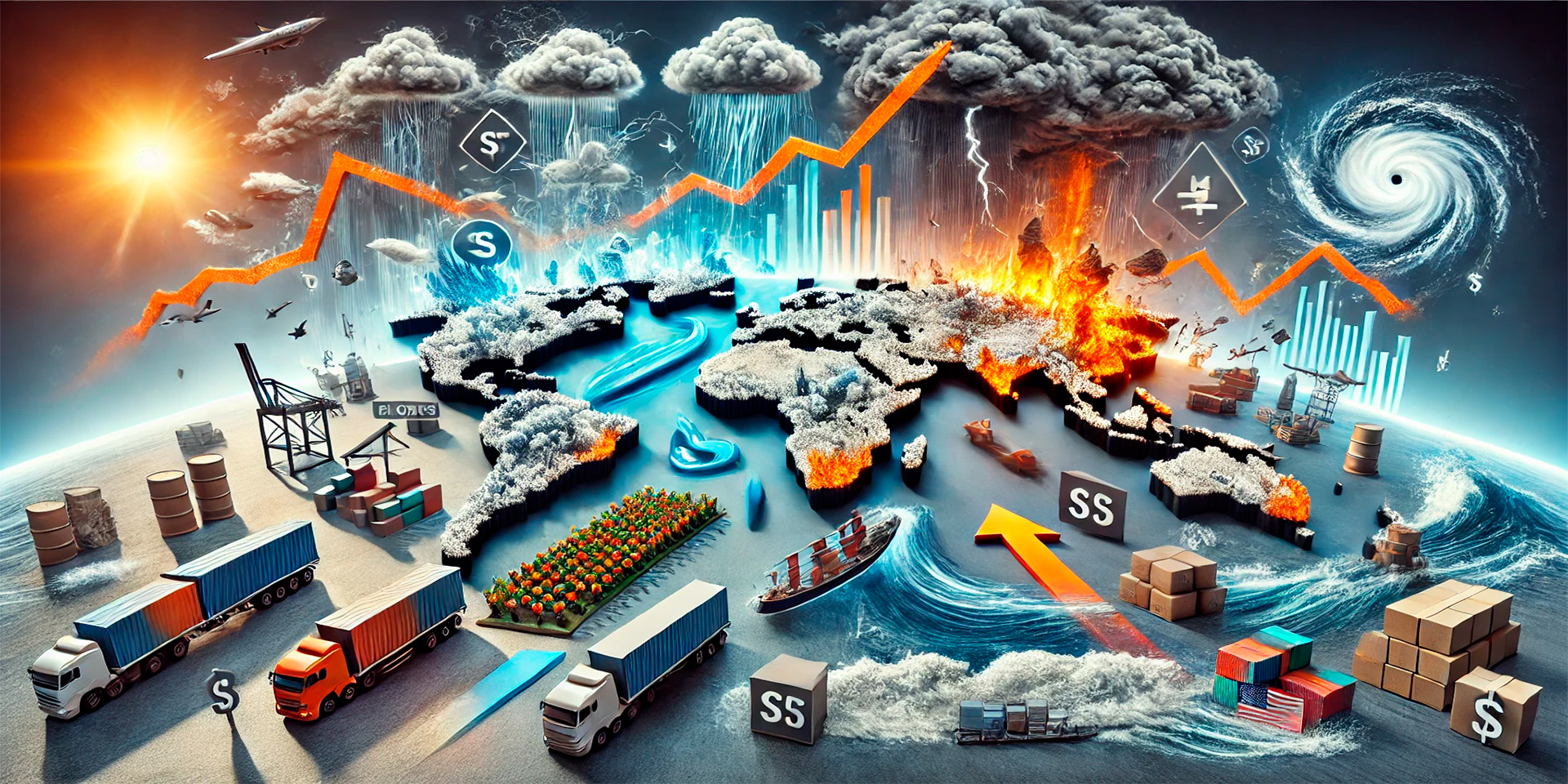
Climate Chaos and Commerce: The Ripple Effects of Weather on Global Trade
Weather conditions have always played a significant role in shaping global trade and influencing the pricing of goods. In today’s interconnected economy, the impact of extreme weather events is more pronounced than ever, leading to disruptions in supply chains, delays in production, and significant fluctuations in the cost of goods. From hurricanes and floods to droughts and wildfires, unpredictable and severe weather conditions can result in shipping delays, crop damage, and increased transportation costs, all of which contribute to price volatility in global markets.
This article explores how weather-related challenges affect global trade and the pricing of goods, highlighting the sectors most vulnerable to these disruptions and examining strategies for mitigating the risks associated with unpredictable weather patterns.
The Impact of Extreme Weather on Global Trade
Extreme weather events can cause significant disruptions to global trade by interrupting the production, transportation, and distribution of goods. In a globalized economy, where supply chains are often long and complex, even localized weather events can have ripple effects that extend far beyond the region where the event occurs. This makes global trade highly susceptible to weather-related disruptions, which can lead to delays in shipping, shortages of raw materials, and increased costs for businesses and consumers.
1. Disruptions to Shipping and Transportation
One of the most direct ways that weather affects global trade is through its impact on shipping and transportation. Severe weather conditions such as hurricanes, typhoons, and heavy snowstorms can disrupt sea, air, and land transportation routes, delaying the delivery of goods across international borders. Ports may close temporarily due to extreme weather, while road and rail transport may be slowed or halted entirely.
When shipping routes are affected by weather, the cost of goods often rises due to increased transit times, higher fuel costs, and the need to reroute shipments through less efficient pathways.
Key ways weather disrupts transportation:
- Port closures: Hurricanes and typhoons can force the closure of major shipping ports, delaying the movement of goods across regions.
- Disrupted land routes: Floods, snowstorms, and landslides can damage roads and railways, halting ground transportation and increasing delivery times.
2. Delays in Production and Supply Chain Interruptions
Severe weather events can also impact the production of goods, particularly in industries that rely on agriculture, mining, or manufacturing. Droughts, floods, and storms can damage crops, delay harvests, or destroy infrastructure, leading to shortages of raw materials that are essential for the production of food, textiles, and other goods. These supply chain interruptions can cause prices to spike as businesses struggle to maintain inventories.
For example, extreme droughts in agricultural regions can lead to crop failures, reducing the availability of key commodities like wheat, coffee, and soybeans. Similarly, floods can damage mining infrastructure, leading to delays in the extraction and transport of essential minerals. In both cases, the reduced supply drives up prices in global markets, creating volatility and uncertainty.
How weather affects production and supply chains:
- Crop damage: Droughts, floods, and storms can devastate agricultural production, leading to shortages of food and raw materials.
- Infrastructure damage: Flooding and extreme weather can damage manufacturing and mining facilities, delaying production and reducing output.

Weather-Related Pricing Volatility in Global Markets
When global trade is disrupted by weather-related events, the pricing of goods becomes more volatile. Weather conditions can lead to supply shortages, increased transportation costs, and higher prices for raw materials, all of which contribute to fluctuations in the price of goods on the global market. These price changes are often felt most acutely in sectors like agriculture, energy, and consumer goods, where supply chains are highly sensitive to weather patterns.
1. Agriculture and Food Prices
The agriculture sector is particularly vulnerable to weather-related price volatility, as crop yields are directly affected by changing weather conditions. Droughts, floods, and storms can significantly reduce the supply of agricultural products, leading to higher prices for food and other raw materials. Additionally, adverse weather conditions can affect the quality of crops, further driving up prices as businesses seek to maintain high standards.
For example, droughts in major grain-producing regions can lead to global shortages of wheat or corn, pushing up prices for bread, cereals, and other staples. Similarly, extreme weather events can impact the availability of fruits, vegetables, and coffee, creating price spikes that affect consumers worldwide.
Impact of weather on agricultural prices:
- Reduced crop yields: Droughts and floods lower agricultural output, reducing the supply of key commodities and driving up prices.
- Increased food costs: Higher agricultural prices lead to increased costs for food products, affecting consumers across the globe.
2. Energy Prices
The energy sector is another industry that is highly sensitive to weather-related disruptions. Extreme weather events can damage energy infrastructure, disrupt the extraction of oil and gas, or reduce the supply of renewable energy sources like wind and solar power. These disruptions often lead to increased energy prices, as reduced supply forces energy producers to raise costs.
For instance, hurricanes in the Gulf of Mexico can damage offshore oil platforms, reducing the supply of crude oil and causing fuel prices to rise. Similarly, extreme cold weather can lead to increased demand for heating fuels, putting upward pressure on energy prices and straining supply chains.
How weather affects energy prices:
- Disruption of energy infrastructure: Hurricanes and storms can damage oil platforms, pipelines, and power plants, reducing energy supply and raising prices.
- Increased demand: Cold weather and heatwaves drive up demand for energy, leading to higher prices for heating and cooling.

Mitigating the Impact of Weather-Related Disruptions on Trade
While weather-related disruptions to global trade and pricing are often unavoidable, businesses and governments can take steps to mitigate their impact. By adopting strategies that enhance the resilience of supply chains and improve forecasting and planning, companies can better manage the risks associated with unpredictable weather patterns.
1. Building Resilient Supply Chains
One of the most effective ways to mitigate the impact of weather-related disruptions is by building more resilient supply chains. This can be achieved by diversifying suppliers, investing in infrastructure improvements, and developing contingency plans to manage potential disruptions. By having alternative sources of supply and robust logistical networks, businesses can better respond to weather-related events and maintain the flow of goods.
Strategies for building resilient supply chains:
- Diversifying suppliers: Relying on multiple suppliers from different regions reduces the risk of weather-related disruptions affecting the entire supply chain.
- Investing in infrastructure: Upgrading ports, roads, and storage facilities helps protect against damage from extreme weather events.
2. Enhancing Weather Forecasting and Risk Management
Accurate weather forecasting and risk management are essential for minimizing the impact of weather-related disruptions on global trade. By using advanced forecasting tools, businesses can better anticipate weather events and adjust their operations accordingly. Governments can also play a role by investing in infrastructure and early warning systems that help mitigate the damage caused by extreme weather.
In addition, companies can adopt risk management strategies such as weather insurance or hedging to protect against financial losses due to weather-related disruptions. These tools can provide a financial cushion during times of uncertainty, allowing businesses to recover more quickly from supply chain interruptions.
How forecasting and risk management help mitigate disruption:
- Early warning systems: Improved forecasting tools provide businesses with the information they need to adjust operations and avoid potential disruptions.
- Weather insurance: Insurance policies designed to cover losses caused by extreme weather events can help businesses mitigate financial risks.
Conclusion
Weather-related challenges are a growing threat to global trade and the pricing of goods. As extreme weather events become more frequent and severe due to climate change, the disruptions they cause to supply chains, production, and transportation will continue to create volatility in global markets. Sectors like agriculture and energy are particularly vulnerable to these disruptions, leading to price spikes and shortages that affect businesses and consumers worldwide. By building more resilient supply chains, improving forecasting, and adopting risk management strategies, companies and governments can better prepare for the impact of weather on global trade and pricing.
